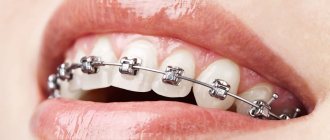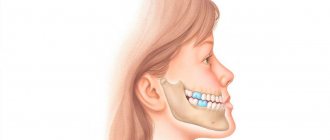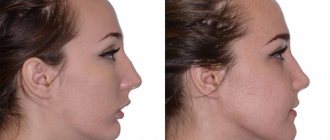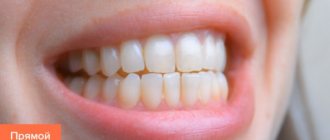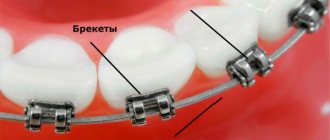If you are reading this article, it means that you are interested in improving your bite and are considering braces.
This shows that you have the determination to achieve a healthy, charming smile.
Here we have collected the questions that people most often write to us in messages.
I hope this changes your life for the better, just like it has changed the lives of thousands of other people.
Can adults get braces to correct their bite?
Anyone can correct a malocclusion, regardless of age. But in an adult, this process takes longer than in children, because skeletal growth has already stopped and hard bones are more difficult to form.
In addition, some oral health conditions may delay the installation of braces. For example, caries, periodontal disease, endocrine diseases.
Sometimes the effect of treatment is influenced by the presence of crowns and bridges. The treatment period starts from 1.5 years.
Symptoms and manifestations
Most often, caries develops in places where bacterial plaque accumulates, that is, in the area where the brackets fit into the enamel surface, as well as at the neck of the tooth.
Damage can be determined by the following manifestations:
- a chalky or yellow spot appears on the enamel , indicating the beginning of the process of demineralization of dental tissues;
- Over time , the stain darkens, becoming brown . It has a smooth shiny surface. There are no visible signs of tooth decay;
- at the site of pigmentation, the enamel becomes painful , reacting to thermal and chemical irritants;
- in the absence of therapeutic intervention by the dentist, a visible defect in the form of a depression forms , formed as a result of the destruction of the surface layer of enamel.
If, after the destruction of a section of enamel, you do not seek help from a dentist, then caries will lead to dentin deformation and can damage the pulp.
Does teeth straightening hurt?
The installation of braces itself is painless, but requires patience because it takes about an hour.
For 7-10 days, teeth may hurt when biting. The body must get used to foreign objects. In general, you live your old life, you just notice pleasant changes in yourself.
Control visits are needed to correct the process and form the correct position of the teeth. Usually after changing the arch the pain goes away within 3-7 days. It all depends on individual sensitivity.
For some, wearing braces is only unpleasant, for others, on the contrary, it is painful, and some do not feel anything.
More information about the irrigator
An irrigator is a small device that consists of a container of water and a nozzle that delivers a thin, elastic, directed stream of liquid. With this jet you can clean your teeth and interdental spaces, and gently massage your gums. Unlike brushes and brushes, the jet penetrates into the most difficult to reach places and provides better removal of bacterial plaque. The consequence of this is the preservation of the original appearance of the structure and tooth enamel, and the absence of an unpleasant odor.
Do braces make it difficult to eat?
Once installed, you will need to learn how to eat in them. This period takes on average 3-7 days.
At this time, give preference to soft and liquid foods. Cut fruits and vegetables into small pieces. Avoid fibrous and sticky foods.
Over time, you will be able to eat almost everything except Coca-Cola (can dissolve glue), hard foods (nuts, crackers, chocolate) and sticky sweets (chocolate, cookies or caramel bars). You should also not chew gum.
How often should inspections be carried out?
Every 1-2 months, it all depends on the defect and the individual structure of the patient’s teeth. During the visit, the orthodontist checks the success of the treatment and sets a vector for the arch, which determines the movement of teeth in the right direction.
Missing follow-up visits may negate the effect of previous treatment. You are also required to visit a hygienist every six months.
Braces, whether external or internal, need to be worn for an average of 1.5 years. But determining more precise timing depends on the initial situation and age of the patient. Sometimes it takes 2 years to eliminate a defect.
When to start treatment?
Treatment of caries should be carried out as timely as possible, both without braces and with them. This is the only chance to preserve the integrity of the affected tooth and the health of the rest.
The treatment procedure for a fixed orthodontic system differs little from the standard therapeutic one. The only difference is in the number of doctors involved in the procedure, as well as in the preparatory manipulations.
To stop caries, the therapeutic process first involves an orthodontist, who removes the arch and, if necessary, peels off the bracket, and then the dentist-therapist gets to work.
At the same time, orthodontic services are usually provided free of charge. In some clinics, orthodontists have sufficient practice to carry out treatment independently, without the involvement of a therapist.
The need to remove structural elements will depend on the location of the pathological focus . In some situations, it is possible to carry out therapeutic manipulations without any preliminary preparation of the field of activity, i.e. without removing the arch.
Removal of the system bracket is necessary only if the cariogenic zone is localized near the bracket or under it.
Removal of the arch may be necessary if the destruction began on the lateral surface of the teeth. It is possible to avoid removing the corrective arch only if the teeth are in the initial stage of movement, during which a wide interdental space is formed between them.
Thanks to this, the dentist can easily prepare the affected surface, without affecting the system and adjacent teeth.
Even if some elements have been removed, the treatment always ends with their re-fixation in exact accordance with the initial position.
What to do if the bracket comes off?
In itself, this happens quite rarely, only in cases of severe crowding of teeth, since the arch puts a lot of pressure on the dentition and the lock falls off. Another option is if the patient is a nut or other solid food lover.
If you find a broken bracket, contact your orthodontist immediately. Otherwise, the teeth will begin to gradually move to their original position. Also remove elastic bands if you wear them.
The doctor sees patients with unstuck braces out of turn. It takes about 5 minutes to glue a new lock.
It also happens that the archwire flies out of the bracket grooves. You can try to get it back yourself. However, this should be done extremely carefully, without damaging the adjacent locks.
When is it better to treat caries with braces?
One of the most difficult types of caries is interdental. It develops between the teeth and lasts for a long time in a hidden form. It can only be detected during an X-ray or laser examination. However, the complexity of the pathology lies not in diagnosis, but in treatment.
Interdental hidden caries forces the doctor to prepare not only the diseased tooth, but also the healthy tooth, since the specialist needs to gain access to the carious cavity and make room for a filling.
If hidden caries develops due to crowded teeth, treatment may be delayed until the defect is corrected. First, the orthodontist will install braces, and after a while, when the teeth change their position a little, he will cure caries. Thus, an orthodontic design can simplify the procedure if a patient is diagnosed with interdental caries due to crowded teeth.
How to brush your teeth with braces?
This is where a traditional toothbrush and toothpaste don't serve their purpose. Therefore, you will need to buy a special orthodontic brush, brushes and floss from the pharmacy. You can also use an oral irrigator if you wish.
This way you can effectively clean your teeth and the area around the locks. Teeth should be thoroughly brushed after each meal, because food debris is deposited on braces, which contributes to the development of caries and does not look aesthetically pleasing. We have repeatedly encountered patients whose teeth are more well-groomed than those of a person without braces.
Causes of caries
Caries, the main disease of teeth, comes down to the destruction of their hard tissues, as a result of which cavities form in them. For a tooth to get sick, just one condition is enough - the formation of plaque on its surface from the remnants of food eaten. Microorganisms living in the plaque layer feed on it and, in the process of vital activity, release aggressive acid that specifically destroys tooth enamel.
To start the destructive carious process, the amount of plaque on the teeth must reach a certain concentration. Remember where cavities most often form? Not at all on the smooth surface of the tooth, where plaque is most easily removed with a toothbrush, but in fissures - depressions on the chewing surface of the teeth, pits and places of particularly crowded teeth, where cleaning is difficult.
Braces themselves cannot destroy teeth. They are glued with a special glue with the addition of a special protector that protects the surface of the tooth under the braces from caries. But along the edges of the bonded bracket, it does create an uneven surface in which plaque can accumulate. Therefore, in patients who pay little attention to dental hygiene, the risk of caries when wearing orthodontic systems increases.
Are braces the last stage of orthodontic treatment?
After removing braces, you need to consolidate the effect of straightening your teeth. For this purpose, retainers are made that will protect teeth from returning to their original place.
There are two types of retainers:
- Removable – transparent, plastic mouth guards. Used only at night or during a certain period.
- Non-removable - made of metal. They are installed on the back surface of the teeth using special composite materials.
The decision on the best method is made by the orthodontist. The aligners must be worn at all times during the first month, removed only for eating and brushing your teeth. On average they are worn for 2 years.
While wearing retention devices, you must visit a doctor every 3-6 months.
After installing the braces system, you experienced unusual sensations
You just got braces installed
After installing the braces system, you experienced unusual sensations
Sensation of a foreign body in the mouth. The lips (tongue) feel a bulky structure in the mouth. Don’t be alarmed, the mucous membrane adapts to the new relief in about 1-2 weeks. Soon you will forget about it. During this period, braces can rub your lips and cheeks - use a special protective wax. A small piece of wax, preheated and kneaded in the hands, is placed on the bracket (another element of the orthodontic structure) and carefully fixed on the entire surface of the bracket, which causes discomfort and pain.
Painful sensations. By the evening after installing the braces system and in the first 3-7 days, you will experience discomfort or pain in the dental area. This is normal and very individual for each patient. If aching pain bothers you greatly and you cannot sleep, then you can use painkillers. For example, ketonal or nise (nimesulide, nimesil) - 1 tablet each. 2 times a day or only at night, no more than 5 days.
Mobility of teeth. From the moment the brace system is installed, teeth begin to move, and they become more mobile for the entire period of orthodontic treatment.
The arc came out behind the last teeth. In the process of moving and aligning the teeth, the arch will straighten and its excess will come out behind the last teeth. It can injure your cheeks. If this happens, you should immediately call our clinic and make an appointment with an orthodontist. The doctor will bite your arch.
The bracket came off. If you follow the recommendations, breakage and detachment of braces are rare, however, they are possible. If your brace has come off (the bracket is not tightly fixed to the tooth and slides along the arch), then you should save it and immediately report it to the clinic. They will make an appointment for you and either the same brace or a new one will be attached.
How to brush teeth with braces?
Any orthodontic device, and even more so a brace system, by definition makes oral hygiene difficult, since it has many cavities where harmful microbes accumulate. Therefore, you will have to brush your teeth more thoroughly and for a long time than ever. It's difficult, but quite possible. You need to be aware of the importance of brushing your teeth.
According to statistics, the risk of caries during treatment with orthodontic appliances reaches up to 85%. This is explained by the deterioration of natural cleaning and the difficulty of access to the vestibular and buccal surfaces of the teeth on which the bracket system is fixed, which dictates the need to include anti-caries measures in the orthodontic treatment plan, namely professional oral hygiene.
Dental plaque consists of a complex bacterial community of different types of microorganisms. It covers the surface of teeth and soft tissues. Mouth saliva washes away food debris and plaque from the surface of the teeth, but cannot completely eliminate them. Therefore, it is IMPORTANT to carry out regular (once every 3-4 months) hygiene measures with a dental hygienist.
In addition, supportive personal hygiene is a reliable guarantee of the health of teeth and periodontal tissues.
A properly selected toothbrush and the method of using it make it possible to effectively control the formation of plaque.
What does poor teeth brushing lead to?
- Plaque, which contains millions of harmful microorganisms, accumulates around braces. They produce acid that eats away the enamel of the teeth, causing white spots. These are areas of demineralization (initial caries), especially noticeable after removal of braces. Nothing happens under the braces themselves.
- Bacterial plaque that is not cleaned from the gums leads to inflammation (gingivitis). The gums begin to hurt and bleed. Patients begin to avoid cleaning in these areas and the situation gets worse. Remember, your gums will bleed until you learn to clean the gum area of your teeth well.
- Due to inflammation of the gums, teeth begin to move more slowly, the treatment period increases
- In case of poor hygiene (cleaning), which is constantly monitored by the doctor, the question of early termination of treatment (removal of the braces) may be raised.
How to brush your teeth?
Necessarily:
1. A regular toothbrush, or a special Oral-B Ortho toothbrush (has a V-shaped depression along the central part of the bristles, following the contours of the braces and other orthodontic structures), it must be changed every 2-3 months.
2. A brush with special brushes and a set of brushes for it. The brushes need to be replaced every week, as they quickly wear out and lose their cleaning ability.
Desirable:
1.Superfloss (special dental floss for patients with braces, to clean the interdental spaces)
Floss is a type of dental floss. The flossing method allows you to remove up to 80% of plaque from contact surfaces. The main condition for the effectiveness of floss is its daily use.
During orthodontic treatment, it is recommended to use superfloss, which consists of three parts of different diameters that flow into one another. To clean the inner surface of the orthodontic arch, superfloss is inserted under the arch, and to clean the bracket along the perimeter and the adjacent part of the tooth enamel, which is especially subject to demineralization, the superfloss is circled around the bracket and forward movements are made.
2. Mono-tuft toothbrush (it is convenient for cleaning the back teeth, especially around braces, as well as hard-to-reach areas and the gingival surface of the teeth)
When should you brush your teeth?
Within 7-10 minutes after each meal. If it doesn’t work out for some reason (study, work, etc.), then brushing your teeth is allowed 2 times a day - morning and evening, and during the day after eating it is strongly recommended to rinse your mouth with a mouthwash (anti-caries or anti-inflammatory), or at least with plain water.
How to brush your teeth?
- A regular toothbrush or an orthodontic toothbrush with a horizontal groove
10-15 horizontal movements in each of the three segments (lateral teeth on the right, front teeth, lateral teeth on the left). After horizontal movements, vertical sweeping movements are carried out with the same brush along the outer surface of the teeth from the gums to the edge of the tooth. The internal and chewing surfaces of the teeth are cleaned using the usual method (sweeping back and forth from the gum to the cutting edge of the tooth). If you have an internal braces system (lingual), then cleaning is the same, only from the inner surface of the teeth
- Brush with brushes.
The movements must be reciprocating. The surface of the tooth under the arch and around the bracket is cleaned
- Dental floss (superfloss)
Used to clean interdental spaces. The thread is first inserted under the arch and then into the interdental space. In each interdental space, 4-5 movements are performed in the vertical and anteroposterior direction
- Mono-tuft toothbrush
I use it as an aid for cleaning plaque. They are designed to clean the gingival philtrum and narrow interdental spaces using sweeping and circular movements around the bracket and along the gums.
- Rinse aids
Rinse aids are additional hygiene products. They are available in the form of ready-to-use solutions or liquid concentrates, which must be diluted in certain proportions before use. Mouthwashes often contain Listerine, triclosan, sangavirin and other components of plant origin. The combination of these components leads to a decrease in the intensity of plaque formation.
In addition, it is necessary to carry out professional oral hygiene by visiting a hygienist once every 3-4 months.
Diet restrictions
During treatment, you should use foods such as:
- Sticky, sweet foods (taffy, toffee, chewing gum, chips, waffles, crispbread, cookies, halva). These products stick to the braces in a way that makes them very difficult to clean. Foods high in sugar are a haven for caries microbes, which instantly convert sugar into acid, which can cause tooth decay.
- Hard foods (nuts, candies with nuts, dried bread, bagels, crackers) can break the archwire, peel off the braces, and tear off the rings. Hard vegetables and fruits (carrots, apples, etc.) cannot be bitten off; they are cut into small pieces. This also applies to tough meats and any foods that require biting. Failure to follow these recommendations leads to the braces coming off, which prolongs the treatment period.
{jlcommentspro}
Can you continue to live with crooked teeth?
Crooked teeth are more vulnerable to tooth decay and periodontal disease. If teeth grow incorrectly, their surfaces become excessively worn down when eating, which worsens the malocclusion. Therefore, sometimes it leads to serious diseases of the temporomandibular joints.
In addition, if you suffer from frequent headaches, chondrosis, or have tinnitus, it is better to check your bite.
Braces hurt the oral cavity, what should I do?
After installing braces, each patient receives wax for locks from the orthodontist. At the very beginning, it is worth applying it to the entire system, because the mucous membrane in the oral cavity is not yet accustomed to contact with foreign objects.
Abrasions and wounds heal very quickly. Their healing can be accelerated by using agents that promote the healing of wounds in the oral cavity.

